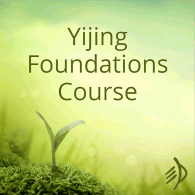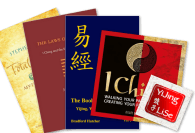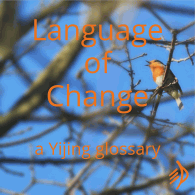Hexagram 1 is so simple it’s tremendously hard to get to grips with. The simplicity starts with its shape –

– six solid, ‘yang’ lines, pure and whole, light with no shade, no nuances, no spaces, no ‘picture’.
The significance of those six solid lines is a bit easier to see in contrast to Hexagram 2, Earth: six open, yin lines:

‘Creative Force is firm; the Earth is open.’ (Zagua) Solid lines act; open lines are acted on, or in. Because earth is open, we can work it – dig, shape, plant, change what grows. But ‘the heavens move ceaselessly’ and time passes, and there’s nothing here we can act on.
The simplicity continues with the text. Whereas Hexagram 2 burgeons with imagery – the mare, the noble one finding her way between confusion and the shining light of a ‘master’, compass points, partners, peaceful homecoming – here is the whole oracle of Hexagram 1:
乾元亨利貞
– all five characters of it, qian yuan heng li zhen.
‘Qian.
From the source, creating success.
Constancy bears fruit.’
What is qian?
The name of the hexagram, qian, isn’t very approachable. Harmen Mesker, someone we can rely on to tease out the ancient meaning of a character for us if anyone can, says he ‘doesn’t know how to translate it’.
His deep dive into qian concentrates on the left and upper right parts of the character, which he finds represent the banner raised at the centre of a settlement, with all the buildings facing towards it. So qian is the centre, the focus, the source of identity; you look to it and arrange your life around it. This fits well with qian‘s association with heaven, sun (a component of the character) and stars: you look to them to know what time it is and order your life accordingly. The staff of the banner may also act as the gnomon of a sundial.
Stephen Field’s excellent Duke of Zhou Changes calls Hexagram 1 ‘The Vigorous’ and says, ‘Qian‘s meaning is derived from the lower right hand element in the graph depicting the “twist” of a newly emerged sprout. The full character means “to shoot upwards,” and refers to the vigor of new spring growth.’ I’m not sure, but I think this is the one element of the character Harmen doesn’t regard as germane to the meaning.
I think both meanings – banner and sprout – come together in the hexagram. It means both absolute truth – the answer to all ‘why?’ questions – and also how that truth makes itself known: in motion, with endless creative vigour. Truth in motion is Creative Force. It moves stars; it makes acorns grow into oak trees. The Tuanzhuan for hexagram 1 says,
‘Clouds pass, rain falls, the variety of beings flow into form.’
(Bradford Hatcher’s translation)
Creative Force is ineluctable and irreducible. It will not change itself for us – which is why qian is the focus, and we must build around it.
And finally – well, actually not remotely finally – the character qian appears in the text of the Yi. In 1 line 3, ‘the noble one qian qian to the end of the day’ and is still alert at nightfall. This line’s change shows Hexagram 10, Treading (the tiger’s tail). The picture arises of relentlessly driven creative energy – the artist who forgets to eat or sleep because he is so perilously, breathtakingly close to Creative Force. And in the fourth and fifth lines of Hexagram 21, qian means ‘dried’, as in sun-dried meat. Perhaps 1.3’s noble one will also be ‘sun dried’ by exposure to such relentless power – ‘burning out’, we’d call it – but the line says this is no mistake.
Yuan heng li zhen
Yuan heng li zhen – which I usually translate ‘from the source, creating success; constancy bears fruit’ – are fundamental words to the Yijing, subtly combined and varied through most of the hexagram texts. Because they appear so often, it’s easy to pass over them and look for something more colourful and easier to relate to. Which would, of course, be a mistake.
Yuan means source, first or primary – like the founding ancestors. Although it’s often translated simply as ‘great’, in readings it points to something that’s great because it’s at the origin, connected to source. In human terms, think of inspiration, the reason why, the original big idea. (But the idea of yuan could be much bigger than that. Everything has a source.)
Heng is normally translated ‘success’; its ancient meaning has to do with offerings. But ‘offering’ isn’t a complete translation, because heng is a two-way thing, like ‘conversation’ in English: it means both the people making the offering and the spirits enjoying it – the shared meal. If you think about it, an offering both made and received is pretty much the definition of success. Any action with heng connects into deep reality to become spiritually potent – it works as a shared meal with the spirits.
Yuan heng is translated as a single phrase: ‘creating success from the source’ or ‘primal offering’. It’s an accepted offering open and connected to source – successful action empowered by its originating idea.
Li quite literally means ‘fruitful’: the old character shows the grain as it is cut. Li action bears fruit – has results – ‘furthers’, in Wilhelm/Baynes.
Zhen, like heng, has both an ancient meaning and a derived one. Originally it means ‘divination’: the whole act, the full conversation of asking or bringing one’s intent and receiving an answer. From here comes the idea of ‘constancy’: the oracle’s answer fully received, inwardly known, and requiring you to hold to it. The whole divination – from the original clear intent, through the oracle’s advice and affirmation, to internalisation of the response – all needs to translate into consistent, steady action.
Li zhen is also a single phrase: li qualifies zhen, meaning ‘fruitful divination’ – but that means not just ‘nice, positive answer’ but that the whole divination bears fruit.
The complete expression, yuan heng li zhen, occurs in just a select few hexagrams. When it does, it points to a tremendous creative drive at work, from the source through into reality. Something wants to happen, to become manifest.
Most of the other 63 hexagrams contain variations on the yuan heng li zhen pattern, and each variation carries meaning. But hexagram 1 is the theme for all those variations: the pure pattern of divination-becoming-action (or truth-becoming-action), with no qualifiers or conditions. It’s the same simplicity that’s embodied in the six active yang lines: all light, no shade. The Wenyan Wing says of qian, ‘Its true greatness lies in the fact that nothing is said about the means by which it furthers [li].’
Its greatness lies in this – and frankly, so too does the difficulty in really engaging with this hexagram in readings. Heaven has no ‘handles’ for us. What to do with hexagram 1 in a reading beyond saying, ‘Oh, there must be lots of creative energy involved…’?
Riding dragons
For specifics, naturally you look to the moving lines – and there, more often than not, you find dragons. (The dragon isn’t named in lines 3 and 4, the ‘human positions’ of the hexagram, but he’s implied, especially at line 4.) If someone’s having difficulty getting a feel for hexagram 2, I might recommend that they spend time with horses to understand the ‘mare’s constancy’. With hexagram 1… this is obviously trickier
There are two stories told about hexagram 1’s dragon. SJ Marshall in The Mandate of Heaven explains the annual cycle of the rain dragon: how it overwinters underwater in a mountain gorge, wakes in spring and flies over the fields, bringing the vital rain. When the people see the first clouds begin to gather, they climb the mountain, make noise and throw things into the lake to anger the dragon into waking so that those clouds will bring rain. (He’s found records of such rites continuing into the 1930s.)
Thus at line 1 the dragon is still asleep underwater; at line 2 the clouds appear; at line 4 the dragon is leaping from the abyss, and by line 5 the rain has come. All of which makes good sense when you consider the simplest meaning of qian in the Yijing itself: ‘dried by the sun’. Qian is drought, and requires rain magic. The hexagram overall is about bringing rain – awakening potential into action.
But there’s also a bigger and more remote dragon here: the Azure Dragon, a vast asterism whose journey across the night sky governs the farming year. In midwinter it is entirely hidden below the horizon, dormant in the waters beyond the end of the world. In late winter the dragon’s horn rises above the horizon at dusk; through spring it emerges, and by summer solstice the whole dragon from horn to tail is ‘flying in heaven’. Stephen Field in The Duke of Zhou Changes translates line 6 as ‘setting dragon’, literally ‘necked dragon’: the dragon’s head has disappeared below the horizon, decapitating it. And then (in the text linked with all lines changing) the dragon with no head is ‘gathered’ entirely below the horizon: ‘As the seasons progress, the Dragon completely disappears below the western horizon where it fights for supremacy with the Heavenly Turtle (Corona Australis). The prognostication of “good fortune” portends victory for the Dragon and the rebirth of the year.’
These seem to me to be two parallel images of the same essential dragon, overwintering both in the local Dragon Pool and in the watery abyss beyond the world. Where they seem to differ is in how we can relate to them: observing the constellations as your almanac and acting accordingly, or actively setting out to wake the dragon. (Marshall suggests translating 1.1 as ‘Submerged dragon is of no use,’ implying that you should be waking it up – but the negative used in this line is typically an imperative, ‘Do not!’) Observe and obediently follow celestial timing, or invoke the powers of nature with magic?
Reading through the Wings on Hexagram 1 helps answer this question – by revealing it to be a false dichotomy. Following celestial timing is not a passive thing:
‘Great light completes then begins
The six positions are by season fulfilled
Seasons to mount the six dragons
And with these to master the skies.’
(Tuanzhuan, Bradford Hatcher’s translation.)
This is about timeliness: watching the dragon, always being able to answer the question, ‘What time is it?’ and know the right action for the moment. (Yuan heng li zhen – pure divination.) And if you know what is right in the moment… then you might also know the power that creates rightness – qian. You might be said to be riding the dragon.
This image comes with ancient echoes: KC Chang in Art, Myth and Ritual describes how certain animals, not least dragons, ‘served as the helpers of shamans and shamanesses in the task of communication between heaven and earth, the spirits and the living.’ In the Classic of Mountains and Seas, riding dragons is ‘invariably associated with agents bringing messages back and forth between heaven and earth’ – such as a hero who returned to earth from his audiences in heaven bringing a particular set of songs.
The Wing authors’ choice of image echoes the same understanding: if you can ride dragons, you are in communication with heaven. ‘Riding’ (the verb’s the same one used in the Yi for ‘driving’ a team of horses) suggests mastery, but plainly doesn’t imply that you impose your will on the dragon – rather, it’s that your will and the dragon’s will are the same. And so your intent resonates with Creative Force and your action is timely.
…and isn’t that what magic is? You begin your rituals at the Dragon Pool not on a whim, but when you see the first clouds. Watch the heavens, and you know when to make magic. And then –
‘The heavens move ceaselessly.
A noble one in his own strength does not pause.’
– it’s your own strength that is ceaseless, because to be in harmony with the time is to be powerful. The Dazhuan, in its list of culture heroes who ‘probably got their idea’ from particular hexagrams, says of the ancient sage kings: ‘The Yellow Emperor, Yao and Shun let their robes hang loosely down, yet all under heaven was well-ordered. They probably got the idea for this from Qian and Kun.‘

Hexagram 1 in readings
Each line that changes in Hexagram 1 is an opening: solid becoming open, creating space for action. When none of the lines is changing, there is no such space, only unbroken Creative Force. Quite often this means something like, ‘Potent idea! How could it become manifest?’
When lines in 1 change, the relating hexagram is an exact map of the openings for manifestation: the field of action for creative force, the form it can flow into.
And the experience of Hexagram 1 as relating hexagram itself may be of a much bigger reality – larger scale, longer term – that puts your experience, efforts and motives into perspective. Depending on the situation and your action (in other words, depending on the primary hexagram and which lines must change to give this relating hexagram), it might magnify the power of your endeavours and work as a blessing; sometimes it might reveal your inadequacy or untimeliness. But it always seems to say – ‘there is another, bigger way to see this.’
A final note: talking about qian in general terms as I’ve done here, it always sounds vast and splendid: dragons, heaven, creative drive, absolute truth. In readings, it’s not necessarily so grand. Stars, dragons and oak trees have qian, and so too do laundry, bookkeeping and cabbages.









I didn’t actually suggest translating 1/1 as ‘Submerged dragon is of no use’. I said de Visser and de Groot put forward that way of translating it, and I said what the divinatory consequence of that reading would be (Mandate, p210 n13). I favour ‘do not act’, although in actuality the dragon simply will not act, it is too early, so to say ‘do not’ is not advice for dragons but rather for humans who want to be like dragons.
Really, I think 1/1 is ‘Do not use!’ rather than ‘Do not act!’ Not acting is simply the effect of not using.
Using what? The submerged energy, that is still developing and has not yet arrived at its time. This is natural for a dragon, but a human tends to be impetuous, so the example of the dragon is given. Even a dragon cannot act until the time is right.
Thank you for the correction and for the thought. I agree on ‘do not use!’
‘Use’ in the Yijing seems quite hard to describe. I understand it as ‘use this reading’, in other words ‘use the quality of the time this reading identifies’. Submerged dragon time, in 1.1.
Out of interest – is there a line in Hexagram 1 that would represent, ‘Time to make a noise and wake the dragon,’ do you think?
Interesting question, and, now I think about it, there is indeed a good correlation for that.
The dragon appearing in the field in the second line can be seen as storm clouds gathering in the distance, indicating the time to perform sympathetic magic to bring the rain has arrived. Sympathetic magic is about working with the elements to usher in a change that appears to be coming, as opposed to forcing change of which there is no sign. The dragon is not out of the water until the fifth line. The third line changes to hexagram 10, which has the dragon’s enemy the tiger there, so the third line can be seen as actually arousing the dragon. There is a story I mentioned in ‘The Mandate of Heaven’ about a tiger bone being thrown into the water to annoy the dragon and awaken him. Luckily it was tied on a string as it was a little too effective.
So the second line is the sign, the third line is the act, the fourth line is the dragon leaping up from the depths, the fifth is the dragon in the sky.
I’m aware of the ‘use this omen’ or ‘use this reading’ interpretation. That was Kunst’s idea originally if I recall. It seems like a bit of a fudge to me. Why would you use some and not others? Where is the sense it this? What does it mean?
I wrote some time ago about the dragon and the tiger:
http://www.biroco.com/yijing/dragon_tiger.htm
Good thought about line 2. It’d be a good reason to see the great person, too, if that’s a diviner or someone responsible for ritual.
Mm, like ‘profitable divination’ as a translation of li zhen, as if we might have forgotten what we were doing.
Isn’t 用 generally used specifically, telling you what to use or not to use? It fits with the character of 1 in general that it doesn’t qualify it.
On the evidence of hexagram 49/5, I regard the reference to ‘the great man’ in the Zhouyi as exclusively referring to the king. I don’t buy the recent interpretation that it refers to a diviner.
If ‘use’ makes sense as it is, I don’t see the need for it to become some kind of special jargon such as the idea of whether or not to ‘use’ a received omen. But if ‘use’ doesn’t make sense as it is then it will have to be interpreted some other way. This is why later commentary decided ‘do not use’ really meant ‘do not act’. In some lines, such as 29/3, it could simply be a diviner’s note not to use the obtained oracle on a specific occasion, that got incorporated into the text of the Zhouyi. That’s possible. But to make such a thing a blanket interpretation would render it fairly meaningless and it would be following an accidental specificity as if it were a generalism.
‘Li zhen’ is almost exclusively in judgment texts, only three times in the
lines. It may have some sense of being prior to making the divination, ie ‘beneficial to divine’ rather than ‘beneficial divination’ as if it had already been carried out. But these two characters in this order are surprisingly mysterious and I don’t have any certainty about what it means.
I don’t see why one wouldn’t divine in order to find out whether it was beneficial to divine some other matter.
True – for oracle bone divination, which you might imagine could give an answer that said only ‘profitable to divine’ or ‘not profitable to divine’, and nothing else. But why would anyone then copy such a message into the Yi, which gives an entirely different kind of answer?
Perhaps they copied into the Yi because they weren’t sure of its significance either.
The Zhouyi is fragments, meaning comes from imagining what the whole might have been, if indeed there was anything that can be regarded as a whole at all. They probably weren’t thinking New Agers in the 21st century might have trouble with their rough notes. I can’t even read my own handwriting sometimes.
Ah – then that’s where we part company. I see the Zhouyi as an intentionally-composed whole.
I don’t really know what you mean by ‘an intentionally composed whole’ and you probably don’t know what I mean by ‘fragments’, so yes, we do part company there. As for intentionality, I find that fragments often express a deeper intentionality than ‘an intentionally composed whole’. The is a wonderful fragment of Heraclitus: ‘The fairest order in the world is a heap of random sweepings.’
But you probably hold the view that I think the Yi is just a collection of ancient detritus or something, compared with your view that it was composed by the great sage as his gift to the generations. Both views to me are just polarised and simplistic. It’s true, however, that I don’t have much time for naive faith-based Yijing studies, so you are right to pick up on that.
Whoever fully understands the dynamics and the correlation between hexagrams 1 and 2 is certainly a ruler over the earth, in a spiritual sense anyway. The two hexagrams together have an inexhaustible depth of meaning, and refer on one level to the creation of the universe itself. The dragon and the tiger have a significance that is only superficially understood. On one level, and only one, the dragon is the east, where the light comes from, and the tiger is the west. These two are bound to fight sooner or later, and great damage will ensue. Yin and Yang also fight with each other, and the sixth line of each hexagram show the damage created in this fight. Yin and yang are meant to complement each other, but usually they are at odds, and this works on all levels, until ultimately, all things are understood, and then the healing process begins.
I did not mean to be anonymous. The above post was posted by Gene
Thanks for the comment, Gene! (I thought it was you.)
Some brilliant, generous person has just given me a copy of David Pankenier’s Astrology and Cosmology in Early China, which looks to have a whole chapter on the dragons of hexagram 1 and 2.
And yes, describing my work as ‘naïve faith-based Yijing studies’ is about right.
Interesting exchange. Hmmm. Naive faith-based–serendipity seems like a starting point for deeper truth or mystery that gains the attention of an inquiring heart-mind. Adding knowledge and wisdom should not preclude the deepening of wisdom where chance gives way to co-creative possibility and inquiry to greater self-realisation.
Also, lui-ming trans cleary 1yang Hidden Dragon: do not use it Explanation
In the beginning of strength, when the quality of strength is activated, it is like a hidden dragon. This is the time to nuture the sound energy, one should not rely or presume on this strength, so the text say “do not use it”
The activation of strength can be seen in terms of the seasonal as indicated in your discussion of rustic tradition or in the character of the adept whose progress has begun, ergo not just a book of divination but one of a esoteric wisdom tradition in the Taoist sense of celestial cultivation.
䷀乾Hexagram 1/1 is the result of ䷂屯Hexagram 3 “元亨利贞,潜龙,勿用”
坎☵ meaning Water/pitfall, etc
震☳ meaning thunder/dragon, etc.
Hi Thomas,
The ‘result of’…? I’m not familiar with that – can you explain?
modern interpretation hexagram 14 line 5- visit/ flying/ by plane.
duh coming to meet the great man/ dragon on wing . use your brain people!
I wrote a post about Hexagram 1 – Creative Hexagram.
https://everythe.fr/blog/gua_1_20241111
The Creative Hexagram is generally Fortune, representing vibrant creativity and the power of advancement. However, self-restraint and moderate humility are essential to fully realize the grand goals symbolized by the Creative Hexagram. Thus, its positive effect lies in pursuing success with confidence and resilience, while remaining humble and adaptable.